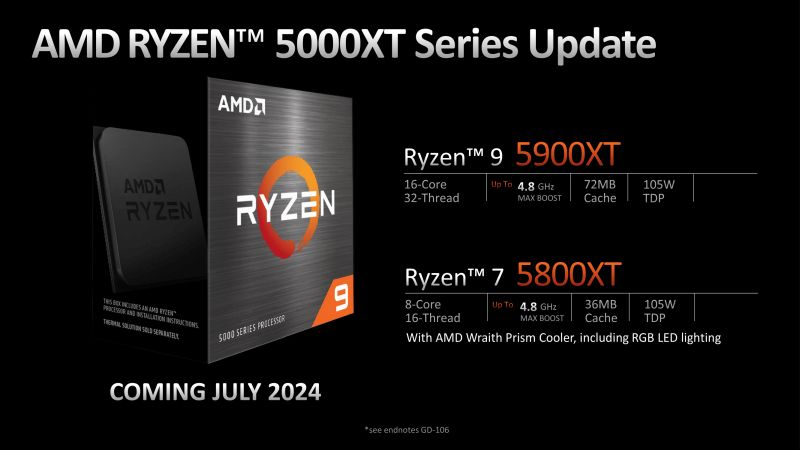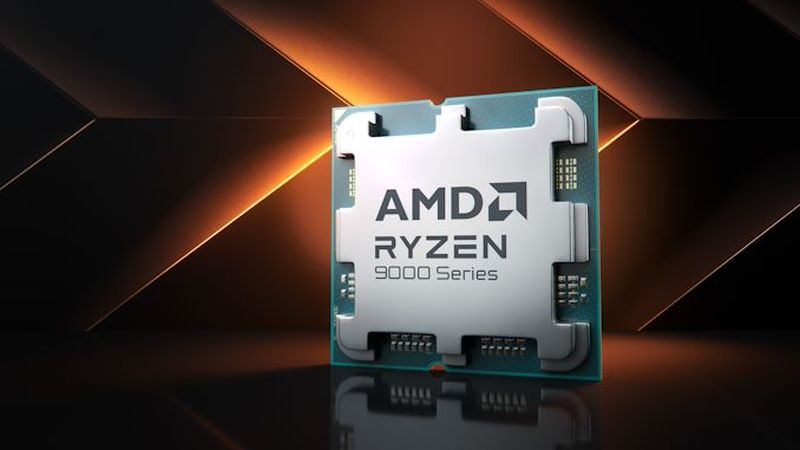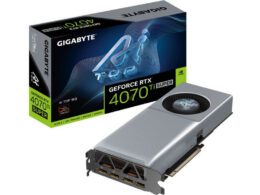During the Computex 2024 event, AMD president Lisa Su shed light on the near future unveiling Ryzen consumer processors with Zen 5 architecture, designed to complement the server Turin. The company announced the Ryzen AI 300 processors for the mobile segment, and added two new models of Ryzen 5000XT to the Ryzen 9000 for motherboards with Socket AM4 connectors.
Essentially, the launch of Ryzen 9 5900XT and Ryzen 7 5800XT processors confirms AMD’s readiness to extend the lifecycle of the Socket AM4 platform significantly beyond the original plan. However, the new processors do not bring any technical revelations. Both predictably use Zen 3 architecture and limit the TDP to 105 W. The former combines 16 cores with 32 threads with a base frequency of 3.3 GHz and a maximum of 4.8 GHz. It integrates 8 GB level-2 cache with 64 MB level-3 cache.

The Ryzen 7 5800XT processor combines 8 cores and 16 threads, has a base frequency of 3.8 GHz, and a maximum of 4.8 GHz. It features a 6 MB level-2 cache and a 32 MB level-3 cache. Both processors come with an AMD Wraith Prism cooler with RGB lighting. According to AMD, the Ryzen 9 5900XT can outperform the Intel Core i7-13700K in some games by 4% in terms of performance. These new processors will go on sale next month, when prices will also be announced.
Furthermore, the eagerly awaited Ryzen 9000 (Granite Ridge) desktop processors, which bring Zen 5 architecture to this segment, are of particular interest. Four models, each featuring Socket AM5, are expected to hit the market in July. Additionally, AMD is unveiling new chipset sets, with X870E and X870 making their debut in new motherboards in July. Notably, the new AMD chipsets will support Wi-Fi 7, while USB 4.0 ports will come as standard on their basis. The PCI Express 5.0 interface will be available for both, the graphics adapter for communication with the CPU, and NVMe drives. The new generation of Socket AM5 platform will also support more speed modes with AMD EXPO memory.
In comparison with their predecessors, the Ryzen 9000 processors will retain the chiplet layout, with computational chips moving to the TSMC N4 process, while the input-output block chips will continue with the TSMC N6 process. The RDNA2 graphics subsystem features two blocks, with the PCI Express 5.0 line support remaining at 24. Zen 5 architecture imparts improved branch prediction and increased computational pipeline throughput to Ryzen 9000 processors. Command processing is also expected to speed up. Furthermore, the memory interface between level-1 and level-2 cache has been expanded, and artificial intelligence command processing with AVX-512 has been accelerated thanks to enhancements to the relevant blocks.
Zen 5 architecture is expected to provide up to 16% performance boost in certain tasks compared to Zen 4. Each Zen 5 computational chip in Ryzen 9000 processors contains 8 cores, so the top models in the family will remain 16-core. AMD’s press release mentions that the Socket AM5 platform’s lifecycle is planned to last at least until 2027, and considering the exceptional long life of the Socket AM4 in market, this period could extend to the end of the decade. Compatibility of the new Ryzen 9000 processors with existing AMD 600 chipset-based motherboards is provided through a microcode update.

AMD’s debut Ryzen 9000 line-up consists of four models with unlocked multipliers that don’t hamper overclocking. The Ryzen 9 9950X tops this list, featuring 16 cores with frequencies of 4.3/5.7 GHz. Its level-2 cache reaches 16 MB and its level-3 cache is 64 MB, with a TDP of a whopping 170 W. The 12-core Ryzen 9 9900X counts at a maximum of 120 W TDP, and its clock frequencies are only slightly lower with 4.4/5.6 GHz.
Interestingly, the TDP of the two other models in the family is kept within 65 W. The Ryzen 7 9700X combines eight cores with frequencies of 3.8/5.5 GHz, while the Ryzen 5 9600X pairs six cores with frequencies of 3.9/5.4 GHz. AMD presents its flagship Ryzen 9 9950X against the Intel Core i9-14900K, showing a performance advantage ranging from 7 to 56% in a series of popular benchmarks. In gaming tests, AMD’s new product’s advantage ranges from 4 to 23%.





